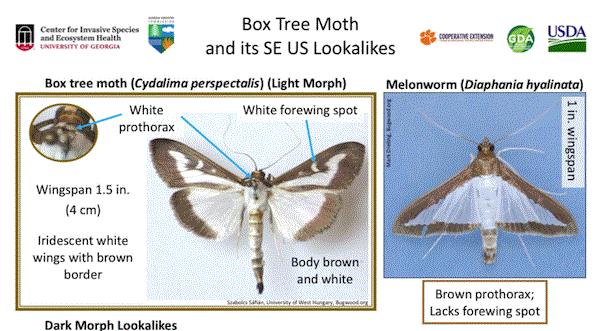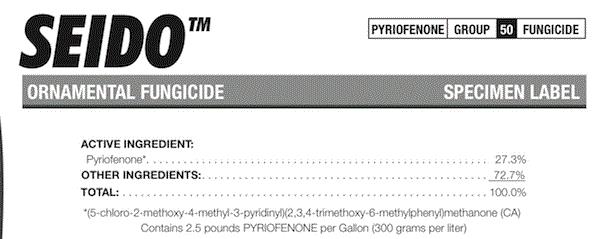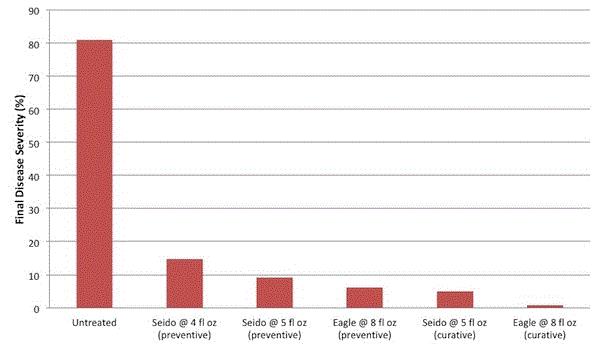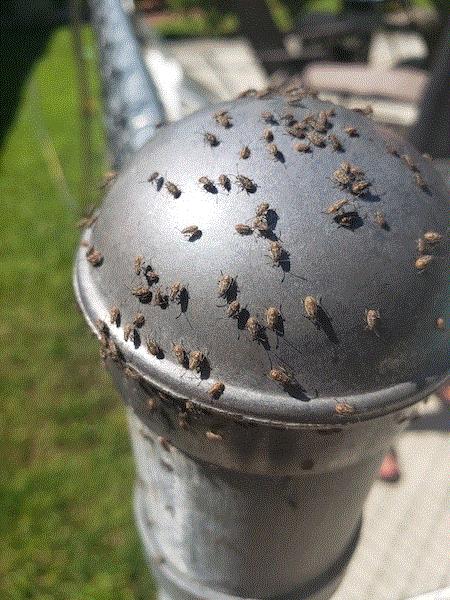Resources to Help Manage Box Tree Moth
Box tree moth was found in several states a little more than a month ago and Rebekah Wallace of the Center for Invasive Species and Ecosystem Health at the University of Georgia was hard at work immediately after the announcement. Rebekah coordinated collaboration among several regulators and entomologists in Georgia and South Carolina to produce education materials about the box tree moth.
These education resources are now available online. The first is a box tree moth factsheet, which provides a summary of its biology. The second resource, which I think will be very helpful in detection and identification, is a pictorial factsheet on the box tree moth and the other moths that look like them. A PowerPoint presentation is also available to those who conduct extension and public education, which saves y’all a little time in pulling together a presentation on this pest.

You can download all three documents, and also a summary of information of the pest, at the EDDMaps website for box tree moth.
Lynn Womack of the Georgia Forestry Commission, David Coyle of Clemson University, Mike Evans of the Georgia Department of Agriculture, Shimat Joseph of the University of Georgia, Carl Lightfoot of USDA-APHIS, and yours truly contributed to the resources. Credit goes to Rebekah for doing the grunt work of finding the images, putting pictures and information together in documents, and publishing them online in a very short time.

Introducing the New Seido Fungicide
OHP, Inc. is introducing a new powdery mildew fungicide called Seido.
The active ingredient of Seido is pyriofenone, which is a completely new mode-of-action group, FRAC 50, for the ornamentals market. The introduction of Seido means that you'll now have one additional rotation partner for other powdery mildew fungicides, such as tebuconazole (FRAC 3) and azoxystrobin (FRAC 11).

Pyriofenone is a translaminar fungicide, which can be used for preventive and early curative treatment of powdery mildew. Pyriofenone stops spore germination, mycelial growth and penetration into plant tissue. The treated pathogen doesn’t produce new spores.
Pyriofenone also has vapor activity, meaning that treatment can prevent infection on adjacent, untreated leaves. Despite this property, thorough coverage of the foliage is recommended. An adjuvant in every application is also recommended to increase efficacy.
Seido targets various powdery mildew pathogens, and is registered for use on ornamental plants in greenhouses and nurseries. The application rate is 4 to 5 fl. oz. per 100 gallons, with a limit of 16 fl. oz. per acre per year or four applications per acre per year. The restricted entry interval (REI) is four hours. The signal word is “Caution” with required personal protective equipment (PPE) as long-sleeved shirt, long pants, socks, shoes and chemical-resistant gloves. Seido may be applied through chemigation.
Carlos Bográn, Senior Technical Manager of OHP, shared with me some efficacy data. Y’all can check out Seido’s information sheet, which includes two studies showing excellent efficacy of Seido against powdery mildew on crape myrtle and gerbera daisy.
Francesca Hand of Ohio State University also did a trial against powdery mildew on phlox. Francesca showed the preventive and curative efficacy of Seido to be comparable to Eagle (myclobutanil; FRAC 3).

(If y’all are wondering, the word “seido” means “accuracy” or “precision” in Japanese.)
Find out more about Seido fungicide by visiting OHP’s website or chat with OHP representatives in Booth 2747 at Cultivate this weekend.

Clarification: Avelyo Fungicide
A month ago, I wrote about the new Avelyo fungicide introduced by BASF. (Read the newsletter again by clicking here.) I presented two examples of the efficacy of Avelyo against Fusarium, as they were reported in the IR-4 database.
Emma Lookabaugh, BASF’s Technical Service Representative for the Southeast, contacted me soon after the publication of the newsletter. Emma pointed out that, although studies against Fusarium were performed through IR-4, Avelyo IS NOT (again, IS NOT) registered against Fusarium at this time. I totally missed that detail and should not have shared the data on Fusarium.
Representatives of BASF are getting inquiries from some of you about the performance of Avelyo against Fusarium. I suppose I should be happy about that in an odd way because that means some of you were actually reading this newsletter and wanted to find out more about what I talked about. That’s more than enough to make up for my embarrassment.
If you’re going to Cultivate, visit the nice folks at BASF in Booth 1439 to find out more about Avelyo fungicide. Or visit BASF's website for more information about Avelyo.

Tell IR-4 What’s Bugging You
If you're a longtime reader of this newsletter, you know that I rely heavily on research data generated by IR-4 and its collaborating researchers. From the efficacy of a fungicide to the crop safety of an herbicide, I can find trusted information on the IR-4’s research database and in the summaries.
IR-4 decides which pests it wants to put its money on based on what y’all need. If enough of you think there's a need to control, say, banana slug, and a company may have a newly developed, super malty stout that has the potential to attract and trap the slug, then IR-4 will play the match-maker and make sure that relevant efficacy and safety data are collected so that the manufacturer can be supported to register said stout for slug management. (Actually, you can use the stout to trap ME.) Before all these can happen, however, you’ll have to tell IR-4 that banana slug is a widespread problem.
So tell IR-4 what’s bugging you by taking its biennial Grower and Extension Survey. The survey has only 10 questions; you can easily answer them in less than five minutes. You can also print a copy of the survey, complete it and mail it in. The deadline for submitting a survey is August 13, 2021.

A Day in JC’s Bug World
… is never dull.
We've had such a nice, cool spring and early summer. But it’s warming up, so bugs abound.
I’ll close this week’s newsletter by sharing with you a picture that may make your skin crawl. (Okay, may be just some of y’all since I know a handful of my readers actually enjoy seeing bug pictures.)
A bunch of baby false chinch bugs had moved away from their forage (grass and various shrubs) in a nearby field and decided to sun themselves on the fence around a pool. Some even decided to go for a swim … with disastrous results.
Obviously, telling a panicky pool lover not to worry about them or just wait them out wasn’t well received, so a perimeter treatment with a pyrethroid was recommended.

See y'all at Cultivate'21!

JC Chong
Professor of Entomology at Clemson University
This e-mail received by 26,766 subscribers like you!
If you're interested in advertising on PestTalks contact Kim Brown ASAP!